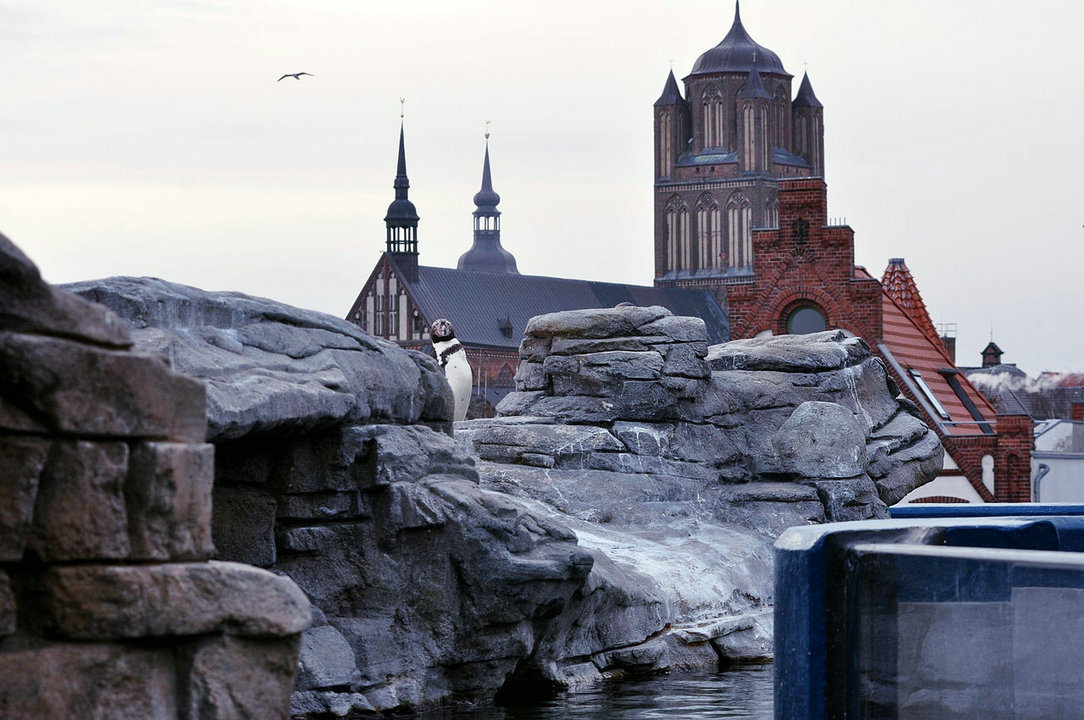The Ozeaneum in the Hanseatic city of Stralsund is a natural history museum with a focus on the sea, which belongs to the German Maritime Museum. It is a main attraction of the German Oceanographic Museum, arguably one of the three largest institutions of its kind in Europe.
Parallel to the exhibitions and aquariums of the main building of the Maritime Museum in Stralsund St. Catherine’s Church, five permanent exhibitions will be shown in the Ozeaneum on the harbor island on 8,700 m² of exhibition space and different water and life worlds from the Baltic Sea, North Sea and North Atlantic will be presented in the aquariums. The largest aquarium holds 2.6 million liters of water.
The German Oceanographic Museum, also called the Museum for Oceanography and Fisheries, Aquarium, in the Hanseatic town of Stralsund, is a museum in which maritime and oceanographic exhibitions are displayed. It is the most visited museum in North Germany. In addition to the main museum building, the actual Oceanographic Museum, there are three other sites, the Ozeaneum, opened in July 2008, the Nautineum and the Natureum.
The Ozeaneum — located at the historical Stralsund harbour on the Baltic coast — opened its doors in July 2008. It displays primarily sea life of the North Sea and the Baltic Sea. The Ozeaneum was expected to be a major tourist attraction, and receive 550,000 visitors per year. It proved to be considerably more attractive than expected, and by the end of the first year had already had over 900,000 visitors. The millionth visit occurred on 27 July 2009. On 22 May 2010, the OZEANEUM Stralsund received the European Museum of the Year Award in a ceremony in the Finnish town of Tampere.
In the Ozeaneum, which opened on 11 July 2008 on Stralsund’s harbour island, there are 39 large aquaria with 7,000 animals from the Baltic Sea, North Sea and Atlantic Ocean, as well as the world’s largest exhibition of whales.
The oceanside shows the five permanent exhibitions “World Sea – Diversity of Life”, “Baltic Sea – The Sea in our Center”, “Exploration and Use of the Seas”, “Sea for Children” and “1: 1 Giants of the Seas” Special exhibitions.
The permanent exhibition “World Sea – Diversity of Life” is the first stop on the oceanside tour. The German Marine Museum dedicated this exhibition to the topic of marine biodiversity. Wall elements inform about the physical and chemical properties of water from different seas, tides and wind and waves. The geological development of the oceans, the global water cycle, the mutual influence of the oceans and the atmosphere, the warming of the climate and also the phenomenon of El Niño are other areas of interest for which information is offered.
A further part of the exhibition is a deep-sea coral, animal fossils, snail shells, alken birds, bar-like fishes, living fossils, parts of the biological collections of the German Marine Museum of algae, corals, shells, snails, creatures, fish, seabirds and marine mammals.
Baltic Sea – The sea in our midst:
The permanent exhibition “Baltic Sea – The Sea in our Center” is dedicated to life in the Baltic Sea. It is sponsored by the German Federal Foundation for the Environment.
An east seerelief represents the depths of the brackish water. Hazardous potentials such as pollution, shipping and pipeline routes are compared with the existing protected areas and national parks on an interactive look. The emergence of the Baltic Sea as well as the habitats and various forms of life are presented.
Models of the three seal species (seals, cones, marigolds) as well as sea eagles, waders, ducks, geese, seagulls and herons are presented in their natural environment.
Exploration and use of the oceans:
The permanent exhibition “Exploration and Use of the Seas” shows how elaborate marine research is and how over-fishing, pollution and shipping affect the seas.
Sea for children:
The permanent exhibition “Sea for Children”, which is aimed primarily at children aged six to twelve, offers the opportunity to playfully deal with the subject of the sea. In a demonstration pool, fish can be experienced “close up”, in the adventure tunnel the deep sea is experienced as in a submarine. On the research station, marine mammals can be viewed under the microscope, the laws of food, flight behavior and reproduction are demonstrated. A listening station brings the children the sound of sea horses, anemone fish and lobsters. Shrimp, sticks and flatfish are shown in small shrimps. The outdoor area with its oversized sea grass meadow is designed as a playground.
aquarium:
The aquariums in the Ozeaneum lead the visitors from the Stralsund harbor basin across the North Sea to the North Sea, showing the marine habitats from the Bodden to the open Atlantic. The biggest aquarium is the pool of 300 m² and a curved, 10 mx 5 m large and 30 cm thick acrylic panorama, which holds 2.6 million liters of water. The other aquariums hold up to 200,000 liters of water and are between two and four meters deep, the smaller basins hold several hundred liters of water.
Among the stone structures in the aquariums are plastic scaffolds supplied by Pangea Rocks. The scaffolds were covered with mesh fabrics and then finished with lightweight concrete and applied with silicate paints. Many of the plants in the basins are artificial, such as a sea grass meadow and up to two meters of algae.
The Nautineum on the island of Dänholm has exhibitions on the topics of fishing, marine research, whale research, hydrography and sea routes.The focal point of the Natureum on the Darß peninsula is nature and the landscape of the peninsula.
The museum was awarded the European Museum of the Year in 2010. From its opening in July 2008 to April 2016, five million visitors were counted.
